Social Determinants of Health: HIV/AIDS in Swaziland & Australia
VerifiedAdded on 2023/06/08
|8
|1739
|275
Essay
AI Summary
This essay provides a comparative analysis of the social determinants of health related to HIV/AIDS in Swaziland and Australia, with a specific focus on the experiences of women. It examines the nature of HIV/AIDS transmission patterns, highlighting the increased rates in Swaziland due to factors like gender inequality and polygamy, versus transmission primarily through men who have sex with men in Australia. The essay explores the impact of stigma, discrimination, and social justice on women's vulnerability to HIV infection in both countries, noting how these factors hinder access to healthcare and perpetuate the spread of the virus. Furthermore, it assesses the role of healthcare systems in managing and curbing HIV infection among women, contrasting the challenges faced in Swaziland's developing healthcare infrastructure with the improved systems in Australia. Finally, the essay discusses the changes implemented in both countries in response to the HIV/AIDS epidemic, including expanded healthcare services and reduced stigmatization, emphasizing the ongoing efforts to improve social justice and accessibility to healthcare for women.
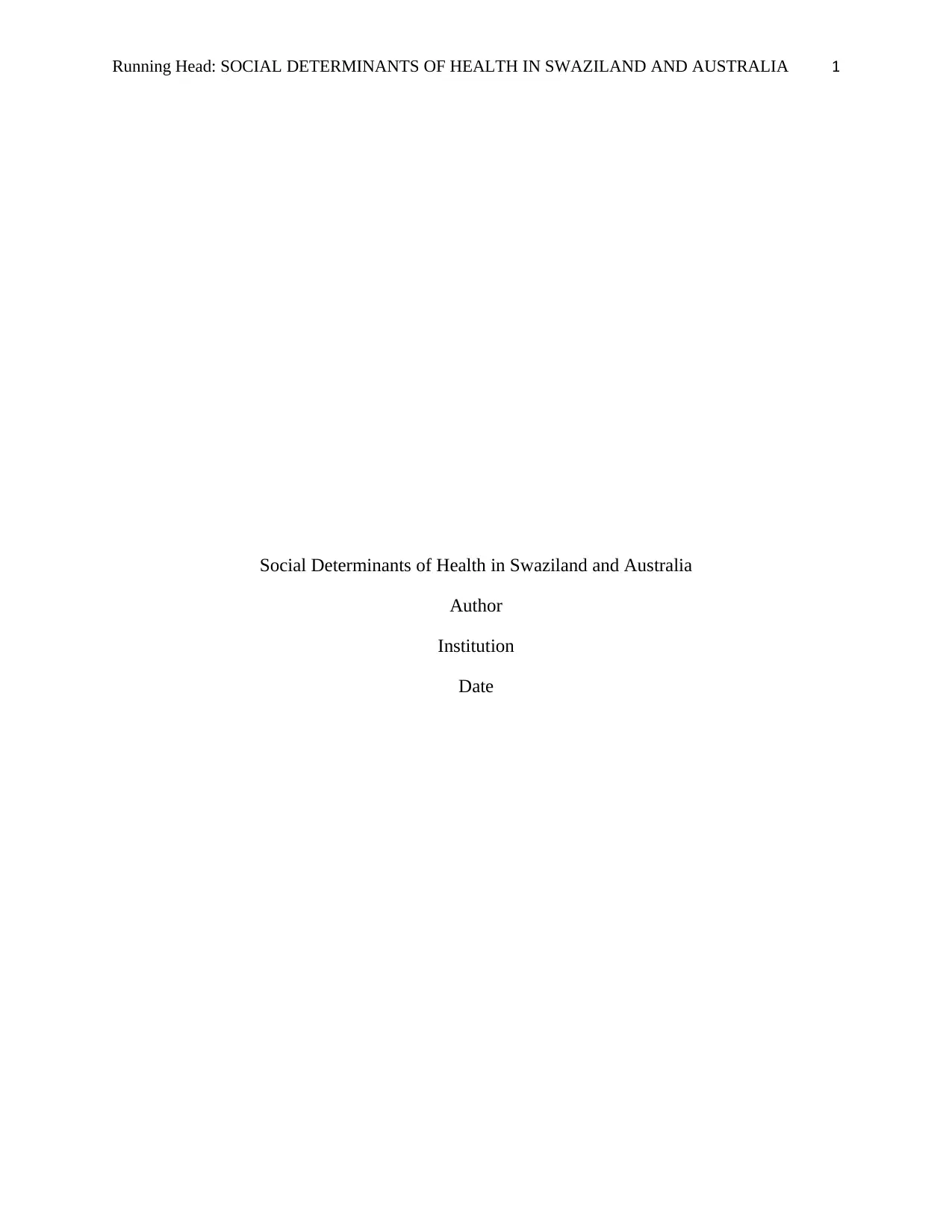
Running Head: SOCIAL DETERMINANTS OF HEALTH IN SWAZILAND AND AUSTRALIA 1
Social Determinants of Health in Swaziland and Australia
Author
Institution
Date
Social Determinants of Health in Swaziland and Australia
Author
Institution
Date
Paraphrase This Document
Need a fresh take? Get an instant paraphrase of this document with our AI Paraphraser

SOCIAL DETERMINANTS OF HEALTH IN SWAZILAND AND AUSTRALIA 2
Social Determinants of Health in Swaziland and Australia
Introduction
In the past few centuries HIV/AIDS has become a common epidemic in most countries.
Research done shows that Swaziland is the country with the highest number of individuals
affected with HIV/AIDS. Swaziland is the country with the highest rates of HIV with about four
out of ten individuals affected by the virus. In Australia a research conducted indicated that at
least 26,400 individuals were living with HIV/AIDS of which ten percent of them did not know
their status.
Among individuals affected by HIV in Swaziland 38% of them are women while only
23% are men (Hawkins, 2018).HIV prevalence among women has been on the rise in Swaziland
as well as Australia. My essay will focus on comparing the effects of stigma, discrimination and
health care systems on women in Swaziland and Australia and how the countries have adapted as
a result of HIV/AIDS.
Nature of HIV/AIDS Transmission Patterns in Swaziland and Australia
In Swaziland the increased rate of the virus is due to the lack of knowledge of how and
the virus is transmitted and negative attitude towards methods that can help in its prevention.
Gender inequality has placed women at a higher risk of getting infected with the virus in
Swaziland (Logie Jenkinson, Mabuza, Madau, Nhlengethwa & Sibiya, 2016). In Swaziland
sexual assault and rape has been on the rise thus increasing chances of transmission.
In Australia most incidences of HIV transmission reported are as a result of sex between
men. Rates of transmission among intravenous drug users are lower compared to that of sex
Social Determinants of Health in Swaziland and Australia
Introduction
In the past few centuries HIV/AIDS has become a common epidemic in most countries.
Research done shows that Swaziland is the country with the highest number of individuals
affected with HIV/AIDS. Swaziland is the country with the highest rates of HIV with about four
out of ten individuals affected by the virus. In Australia a research conducted indicated that at
least 26,400 individuals were living with HIV/AIDS of which ten percent of them did not know
their status.
Among individuals affected by HIV in Swaziland 38% of them are women while only
23% are men (Hawkins, 2018).HIV prevalence among women has been on the rise in Swaziland
as well as Australia. My essay will focus on comparing the effects of stigma, discrimination and
health care systems on women in Swaziland and Australia and how the countries have adapted as
a result of HIV/AIDS.
Nature of HIV/AIDS Transmission Patterns in Swaziland and Australia
In Swaziland the increased rate of the virus is due to the lack of knowledge of how and
the virus is transmitted and negative attitude towards methods that can help in its prevention.
Gender inequality has placed women at a higher risk of getting infected with the virus in
Swaziland (Logie Jenkinson, Mabuza, Madau, Nhlengethwa & Sibiya, 2016). In Swaziland
sexual assault and rape has been on the rise thus increasing chances of transmission.
In Australia most incidences of HIV transmission reported are as a result of sex between
men. Rates of transmission among intravenous drug users are lower compared to that of sex
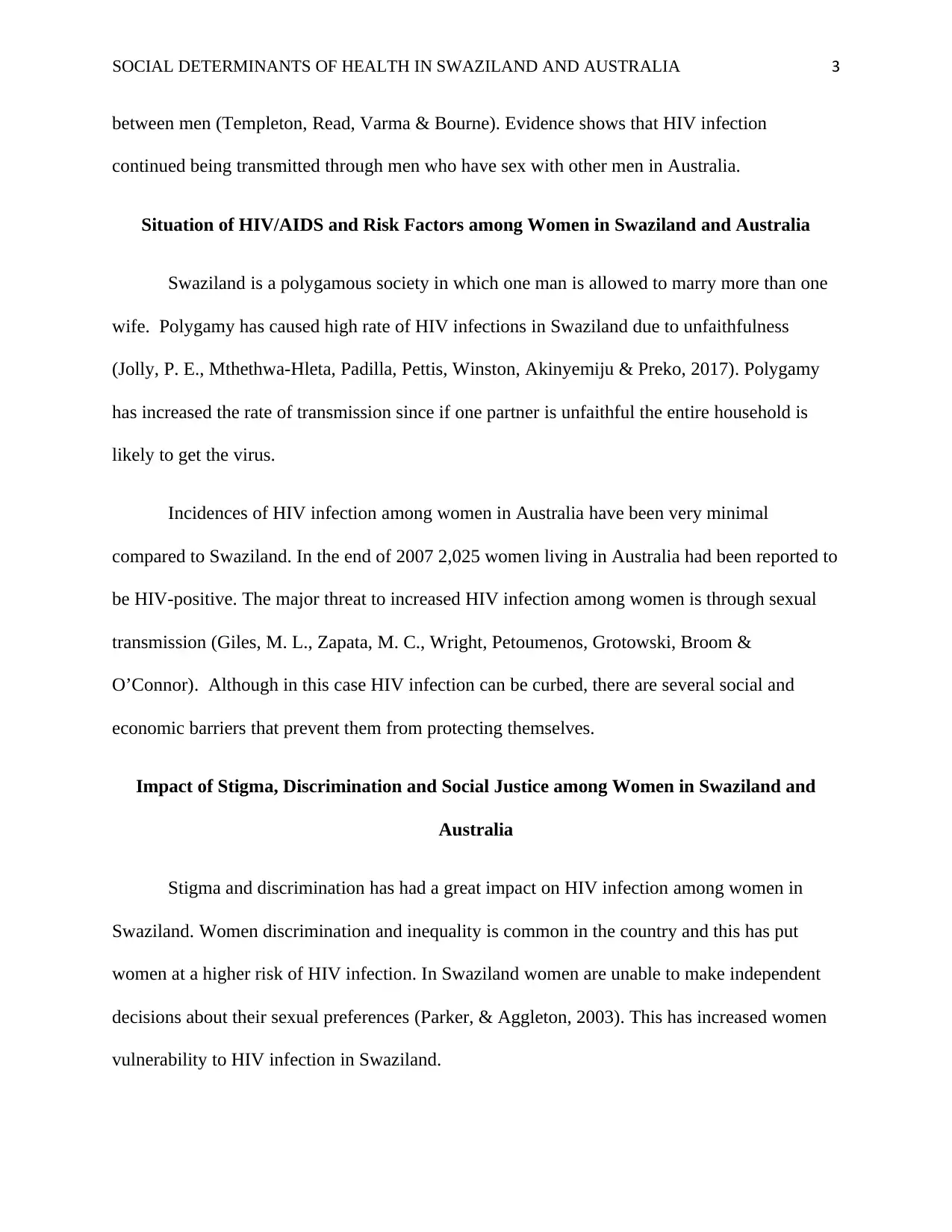
SOCIAL DETERMINANTS OF HEALTH IN SWAZILAND AND AUSTRALIA 3
between men (Templeton, Read, Varma & Bourne). Evidence shows that HIV infection
continued being transmitted through men who have sex with other men in Australia.
Situation of HIV/AIDS and Risk Factors among Women in Swaziland and Australia
Swaziland is a polygamous society in which one man is allowed to marry more than one
wife. Polygamy has caused high rate of HIV infections in Swaziland due to unfaithfulness
(Jolly, P. E., Mthethwa-Hleta, Padilla, Pettis, Winston, Akinyemiju & Preko, 2017). Polygamy
has increased the rate of transmission since if one partner is unfaithful the entire household is
likely to get the virus.
Incidences of HIV infection among women in Australia have been very minimal
compared to Swaziland. In the end of 2007 2,025 women living in Australia had been reported to
be HIV-positive. The major threat to increased HIV infection among women is through sexual
transmission (Giles, M. L., Zapata, M. C., Wright, Petoumenos, Grotowski, Broom &
O’Connor). Although in this case HIV infection can be curbed, there are several social and
economic barriers that prevent them from protecting themselves.
Impact of Stigma, Discrimination and Social Justice among Women in Swaziland and
Australia
Stigma and discrimination has had a great impact on HIV infection among women in
Swaziland. Women discrimination and inequality is common in the country and this has put
women at a higher risk of HIV infection. In Swaziland women are unable to make independent
decisions about their sexual preferences (Parker, & Aggleton, 2003). This has increased women
vulnerability to HIV infection in Swaziland.
between men (Templeton, Read, Varma & Bourne). Evidence shows that HIV infection
continued being transmitted through men who have sex with other men in Australia.
Situation of HIV/AIDS and Risk Factors among Women in Swaziland and Australia
Swaziland is a polygamous society in which one man is allowed to marry more than one
wife. Polygamy has caused high rate of HIV infections in Swaziland due to unfaithfulness
(Jolly, P. E., Mthethwa-Hleta, Padilla, Pettis, Winston, Akinyemiju & Preko, 2017). Polygamy
has increased the rate of transmission since if one partner is unfaithful the entire household is
likely to get the virus.
Incidences of HIV infection among women in Australia have been very minimal
compared to Swaziland. In the end of 2007 2,025 women living in Australia had been reported to
be HIV-positive. The major threat to increased HIV infection among women is through sexual
transmission (Giles, M. L., Zapata, M. C., Wright, Petoumenos, Grotowski, Broom &
O’Connor). Although in this case HIV infection can be curbed, there are several social and
economic barriers that prevent them from protecting themselves.
Impact of Stigma, Discrimination and Social Justice among Women in Swaziland and
Australia
Stigma and discrimination has had a great impact on HIV infection among women in
Swaziland. Women discrimination and inequality is common in the country and this has put
women at a higher risk of HIV infection. In Swaziland women are unable to make independent
decisions about their sexual preferences (Parker, & Aggleton, 2003). This has increased women
vulnerability to HIV infection in Swaziland.
⊘ This is a preview!⊘
Do you want full access?
Subscribe today to unlock all pages.

Trusted by 1+ million students worldwide
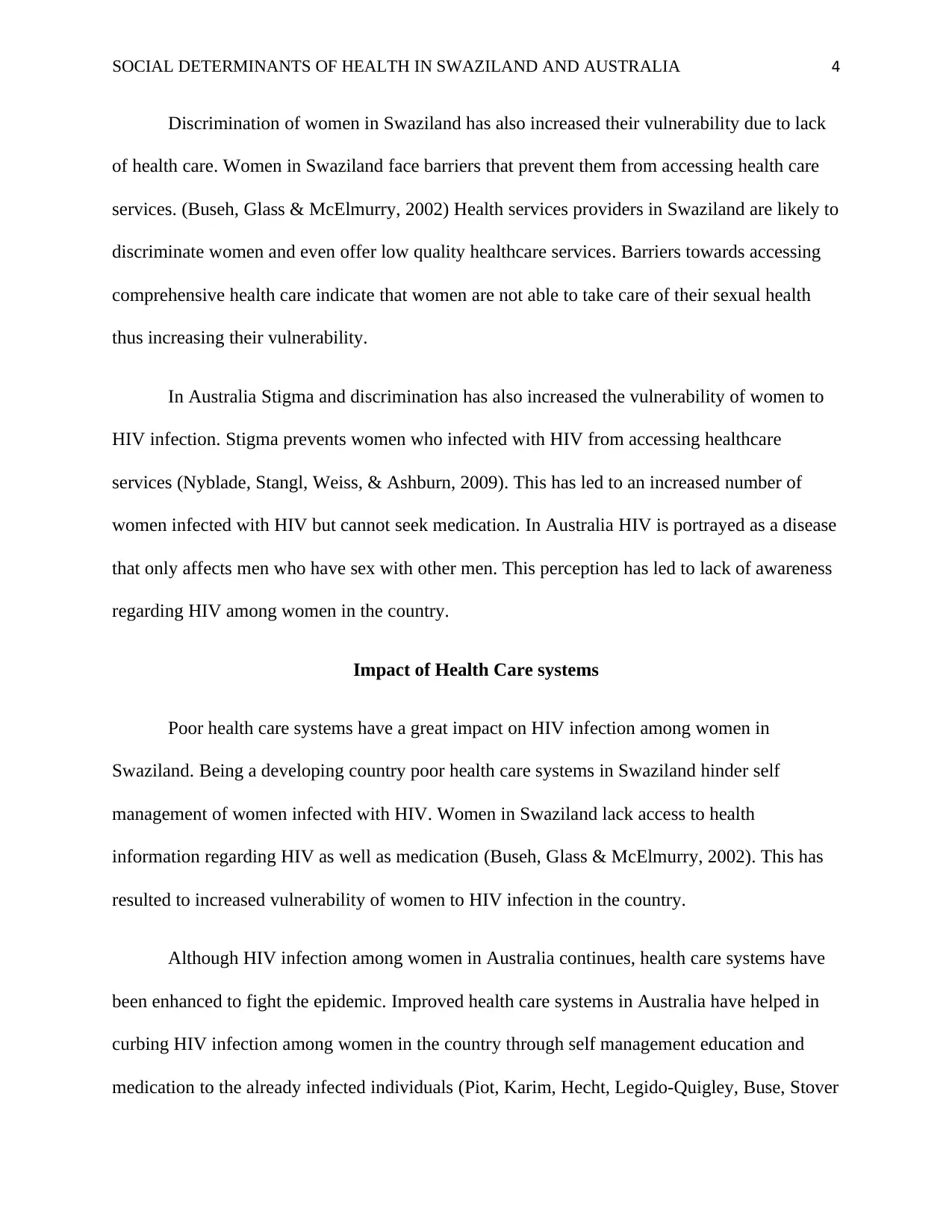
SOCIAL DETERMINANTS OF HEALTH IN SWAZILAND AND AUSTRALIA 4
Discrimination of women in Swaziland has also increased their vulnerability due to lack
of health care. Women in Swaziland face barriers that prevent them from accessing health care
services. (Buseh, Glass & McElmurry, 2002) Health services providers in Swaziland are likely to
discriminate women and even offer low quality healthcare services. Barriers towards accessing
comprehensive health care indicate that women are not able to take care of their sexual health
thus increasing their vulnerability.
In Australia Stigma and discrimination has also increased the vulnerability of women to
HIV infection. Stigma prevents women who infected with HIV from accessing healthcare
services (Nyblade, Stangl, Weiss, & Ashburn, 2009). This has led to an increased number of
women infected with HIV but cannot seek medication. In Australia HIV is portrayed as a disease
that only affects men who have sex with other men. This perception has led to lack of awareness
regarding HIV among women in the country.
Impact of Health Care systems
Poor health care systems have a great impact on HIV infection among women in
Swaziland. Being a developing country poor health care systems in Swaziland hinder self
management of women infected with HIV. Women in Swaziland lack access to health
information regarding HIV as well as medication (Buseh, Glass & McElmurry, 2002). This has
resulted to increased vulnerability of women to HIV infection in the country.
Although HIV infection among women in Australia continues, health care systems have
been enhanced to fight the epidemic. Improved health care systems in Australia have helped in
curbing HIV infection among women in the country through self management education and
medication to the already infected individuals (Piot, Karim, Hecht, Legido-Quigley, Buse, Stover
Discrimination of women in Swaziland has also increased their vulnerability due to lack
of health care. Women in Swaziland face barriers that prevent them from accessing health care
services. (Buseh, Glass & McElmurry, 2002) Health services providers in Swaziland are likely to
discriminate women and even offer low quality healthcare services. Barriers towards accessing
comprehensive health care indicate that women are not able to take care of their sexual health
thus increasing their vulnerability.
In Australia Stigma and discrimination has also increased the vulnerability of women to
HIV infection. Stigma prevents women who infected with HIV from accessing healthcare
services (Nyblade, Stangl, Weiss, & Ashburn, 2009). This has led to an increased number of
women infected with HIV but cannot seek medication. In Australia HIV is portrayed as a disease
that only affects men who have sex with other men. This perception has led to lack of awareness
regarding HIV among women in the country.
Impact of Health Care systems
Poor health care systems have a great impact on HIV infection among women in
Swaziland. Being a developing country poor health care systems in Swaziland hinder self
management of women infected with HIV. Women in Swaziland lack access to health
information regarding HIV as well as medication (Buseh, Glass & McElmurry, 2002). This has
resulted to increased vulnerability of women to HIV infection in the country.
Although HIV infection among women in Australia continues, health care systems have
been enhanced to fight the epidemic. Improved health care systems in Australia have helped in
curbing HIV infection among women in the country through self management education and
medication to the already infected individuals (Piot, Karim, Hecht, Legido-Quigley, Buse, Stover
Paraphrase This Document
Need a fresh take? Get an instant paraphrase of this document with our AI Paraphraser
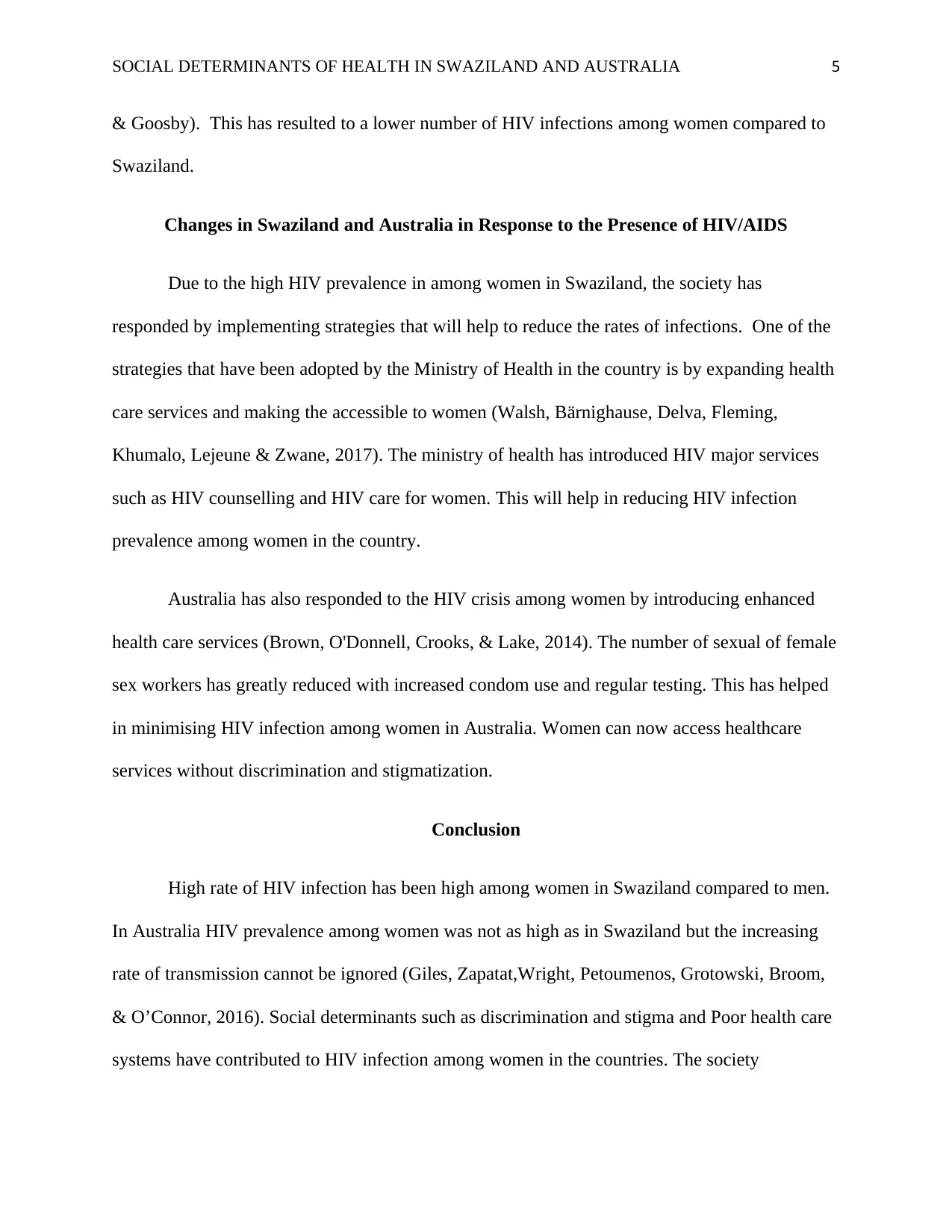
SOCIAL DETERMINANTS OF HEALTH IN SWAZILAND AND AUSTRALIA 5
& Goosby). This has resulted to a lower number of HIV infections among women compared to
Swaziland.
Changes in Swaziland and Australia in Response to the Presence of HIV/AIDS
Due to the high HIV prevalence in among women in Swaziland, the society has
responded by implementing strategies that will help to reduce the rates of infections. One of the
strategies that have been adopted by the Ministry of Health in the country is by expanding health
care services and making the accessible to women (Walsh, Bärnighause, Delva, Fleming,
Khumalo, Lejeune & Zwane, 2017). The ministry of health has introduced HIV major services
such as HIV counselling and HIV care for women. This will help in reducing HIV infection
prevalence among women in the country.
Australia has also responded to the HIV crisis among women by introducing enhanced
health care services (Brown, O'Donnell, Crooks, & Lake, 2014). The number of sexual of female
sex workers has greatly reduced with increased condom use and regular testing. This has helped
in minimising HIV infection among women in Australia. Women can now access healthcare
services without discrimination and stigmatization.
Conclusion
High rate of HIV infection has been high among women in Swaziland compared to men.
In Australia HIV prevalence among women was not as high as in Swaziland but the increasing
rate of transmission cannot be ignored (Giles, Zapatat,Wright, Petoumenos, Grotowski, Broom,
& O’Connor, 2016). Social determinants such as discrimination and stigma and Poor health care
systems have contributed to HIV infection among women in the countries. The society
& Goosby). This has resulted to a lower number of HIV infections among women compared to
Swaziland.
Changes in Swaziland and Australia in Response to the Presence of HIV/AIDS
Due to the high HIV prevalence in among women in Swaziland, the society has
responded by implementing strategies that will help to reduce the rates of infections. One of the
strategies that have been adopted by the Ministry of Health in the country is by expanding health
care services and making the accessible to women (Walsh, Bärnighause, Delva, Fleming,
Khumalo, Lejeune & Zwane, 2017). The ministry of health has introduced HIV major services
such as HIV counselling and HIV care for women. This will help in reducing HIV infection
prevalence among women in the country.
Australia has also responded to the HIV crisis among women by introducing enhanced
health care services (Brown, O'Donnell, Crooks, & Lake, 2014). The number of sexual of female
sex workers has greatly reduced with increased condom use and regular testing. This has helped
in minimising HIV infection among women in Australia. Women can now access healthcare
services without discrimination and stigmatization.
Conclusion
High rate of HIV infection has been high among women in Swaziland compared to men.
In Australia HIV prevalence among women was not as high as in Swaziland but the increasing
rate of transmission cannot be ignored (Giles, Zapatat,Wright, Petoumenos, Grotowski, Broom,
& O’Connor, 2016). Social determinants such as discrimination and stigma and Poor health care
systems have contributed to HIV infection among women in the countries. The society
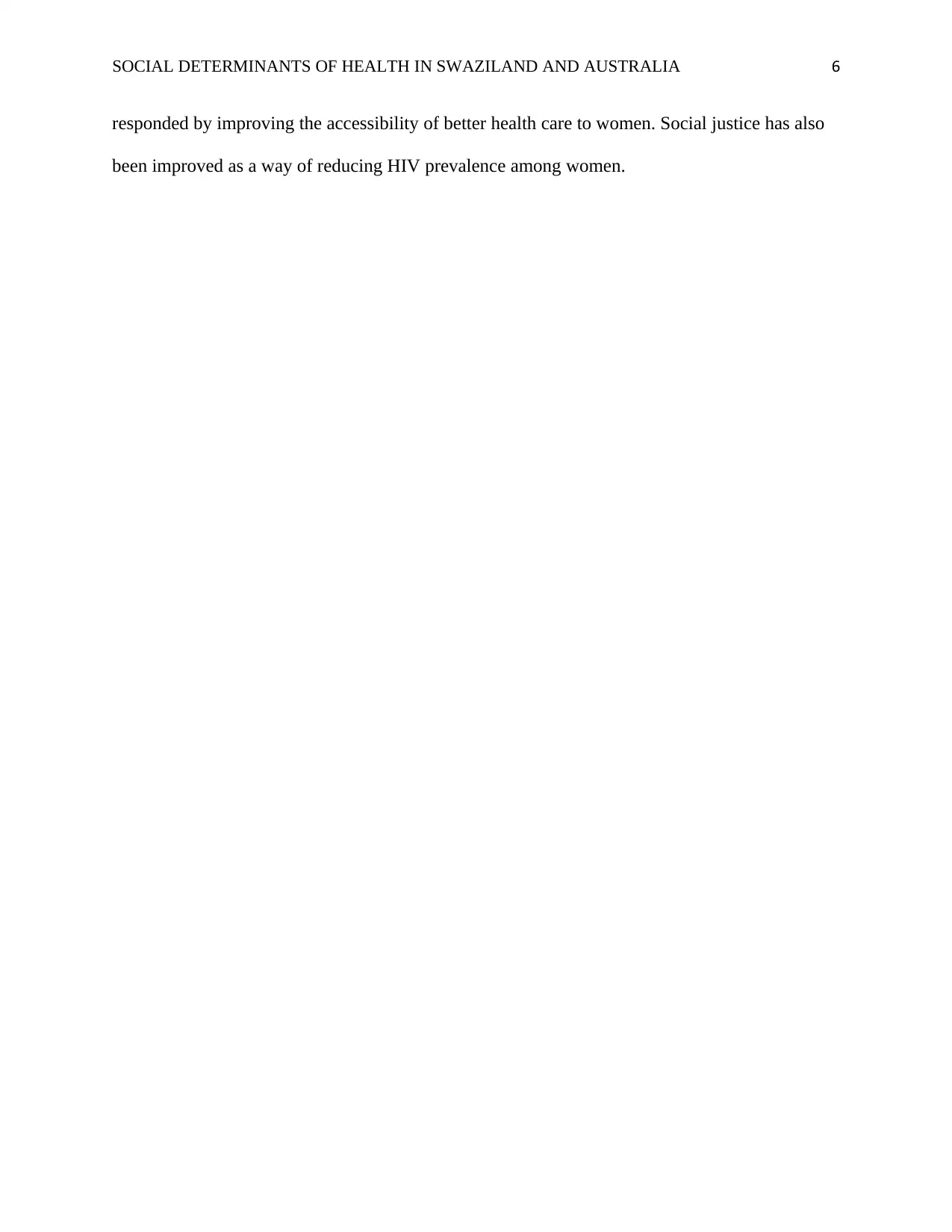
SOCIAL DETERMINANTS OF HEALTH IN SWAZILAND AND AUSTRALIA 6
responded by improving the accessibility of better health care to women. Social justice has also
been improved as a way of reducing HIV prevalence among women.
responded by improving the accessibility of better health care to women. Social justice has also
been improved as a way of reducing HIV prevalence among women.
⊘ This is a preview!⊘
Do you want full access?
Subscribe today to unlock all pages.

Trusted by 1+ million students worldwide
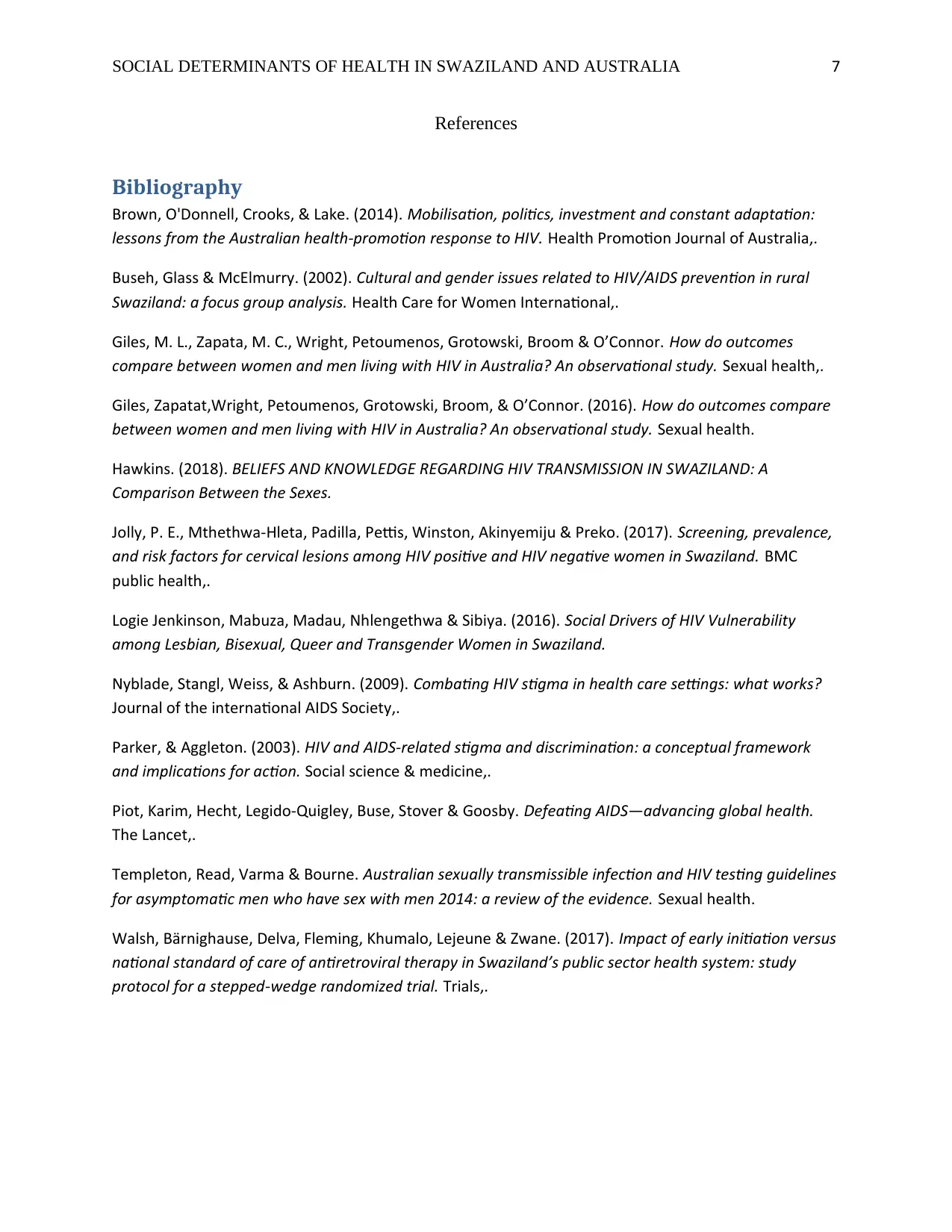
SOCIAL DETERMINANTS OF HEALTH IN SWAZILAND AND AUSTRALIA 7
References
Bibliography
Brown, O'Donnell, Crooks, & Lake. (2014). Mobilisation, politics, investment and constant adaptation:
lessons from the Australian health‐promotion response to HIV. Health Promotion Journal of Australia,.
Buseh, Glass & McElmurry. (2002). Cultural and gender issues related to HIV/AIDS prevention in rural
Swaziland: a focus group analysis. Health Care for Women International,.
Giles, M. L., Zapata, M. C., Wright, Petoumenos, Grotowski, Broom & O’Connor. How do outcomes
compare between women and men living with HIV in Australia? An observational study. Sexual health,.
Giles, Zapatat,Wright, Petoumenos, Grotowski, Broom, & O’Connor. (2016). How do outcomes compare
between women and men living with HIV in Australia? An observational study. Sexual health.
Hawkins. (2018). BELIEFS AND KNOWLEDGE REGARDING HIV TRANSMISSION IN SWAZILAND: A
Comparison Between the Sexes.
Jolly, P. E., Mthethwa-Hleta, Padilla, Pettis, Winston, Akinyemiju & Preko. (2017). Screening, prevalence,
and risk factors for cervical lesions among HIV positive and HIV negative women in Swaziland. BMC
public health,.
Logie Jenkinson, Mabuza, Madau, Nhlengethwa & Sibiya. (2016). Social Drivers of HIV Vulnerability
among Lesbian, Bisexual, Queer and Transgender Women in Swaziland.
Nyblade, Stangl, Weiss, & Ashburn. (2009). Combating HIV stigma in health care settings: what works?
Journal of the international AIDS Society,.
Parker, & Aggleton. (2003). HIV and AIDS‐related stigma and discrimination: a conceptual framework
and implications for action. Social science & medicine,.
Piot, Karim, Hecht, Legido-Quigley, Buse, Stover & Goosby. Defeating AIDS—advancing global health.
The Lancet,.
Templeton, Read, Varma & Bourne. Australian sexually transmissible infection and HIV testing guidelines
for asymptomatic men who have sex with men 2014: a review of the evidence. Sexual health.
Walsh, Bärnighause, Delva, Fleming, Khumalo, Lejeune & Zwane. (2017). Impact of early initiation versus
national standard of care of antiretroviral therapy in Swaziland’s public sector health system: study
protocol for a stepped‐wedge randomized trial. Trials,.
References
Bibliography
Brown, O'Donnell, Crooks, & Lake. (2014). Mobilisation, politics, investment and constant adaptation:
lessons from the Australian health‐promotion response to HIV. Health Promotion Journal of Australia,.
Buseh, Glass & McElmurry. (2002). Cultural and gender issues related to HIV/AIDS prevention in rural
Swaziland: a focus group analysis. Health Care for Women International,.
Giles, M. L., Zapata, M. C., Wright, Petoumenos, Grotowski, Broom & O’Connor. How do outcomes
compare between women and men living with HIV in Australia? An observational study. Sexual health,.
Giles, Zapatat,Wright, Petoumenos, Grotowski, Broom, & O’Connor. (2016). How do outcomes compare
between women and men living with HIV in Australia? An observational study. Sexual health.
Hawkins. (2018). BELIEFS AND KNOWLEDGE REGARDING HIV TRANSMISSION IN SWAZILAND: A
Comparison Between the Sexes.
Jolly, P. E., Mthethwa-Hleta, Padilla, Pettis, Winston, Akinyemiju & Preko. (2017). Screening, prevalence,
and risk factors for cervical lesions among HIV positive and HIV negative women in Swaziland. BMC
public health,.
Logie Jenkinson, Mabuza, Madau, Nhlengethwa & Sibiya. (2016). Social Drivers of HIV Vulnerability
among Lesbian, Bisexual, Queer and Transgender Women in Swaziland.
Nyblade, Stangl, Weiss, & Ashburn. (2009). Combating HIV stigma in health care settings: what works?
Journal of the international AIDS Society,.
Parker, & Aggleton. (2003). HIV and AIDS‐related stigma and discrimination: a conceptual framework
and implications for action. Social science & medicine,.
Piot, Karim, Hecht, Legido-Quigley, Buse, Stover & Goosby. Defeating AIDS—advancing global health.
The Lancet,.
Templeton, Read, Varma & Bourne. Australian sexually transmissible infection and HIV testing guidelines
for asymptomatic men who have sex with men 2014: a review of the evidence. Sexual health.
Walsh, Bärnighause, Delva, Fleming, Khumalo, Lejeune & Zwane. (2017). Impact of early initiation versus
national standard of care of antiretroviral therapy in Swaziland’s public sector health system: study
protocol for a stepped‐wedge randomized trial. Trials,.
Paraphrase This Document
Need a fresh take? Get an instant paraphrase of this document with our AI Paraphraser

SOCIAL DETERMINANTS OF HEALTH IN SWAZILAND AND AUSTRALIA 8
1 out of 8
Related Documents
Your All-in-One AI-Powered Toolkit for Academic Success.
+13062052269
info@desklib.com
Available 24*7 on WhatsApp / Email
![[object Object]](/_next/static/media/star-bottom.7253800d.svg)
Unlock your academic potential
Copyright © 2020–2025 A2Z Services. All Rights Reserved. Developed and managed by ZUCOL.





